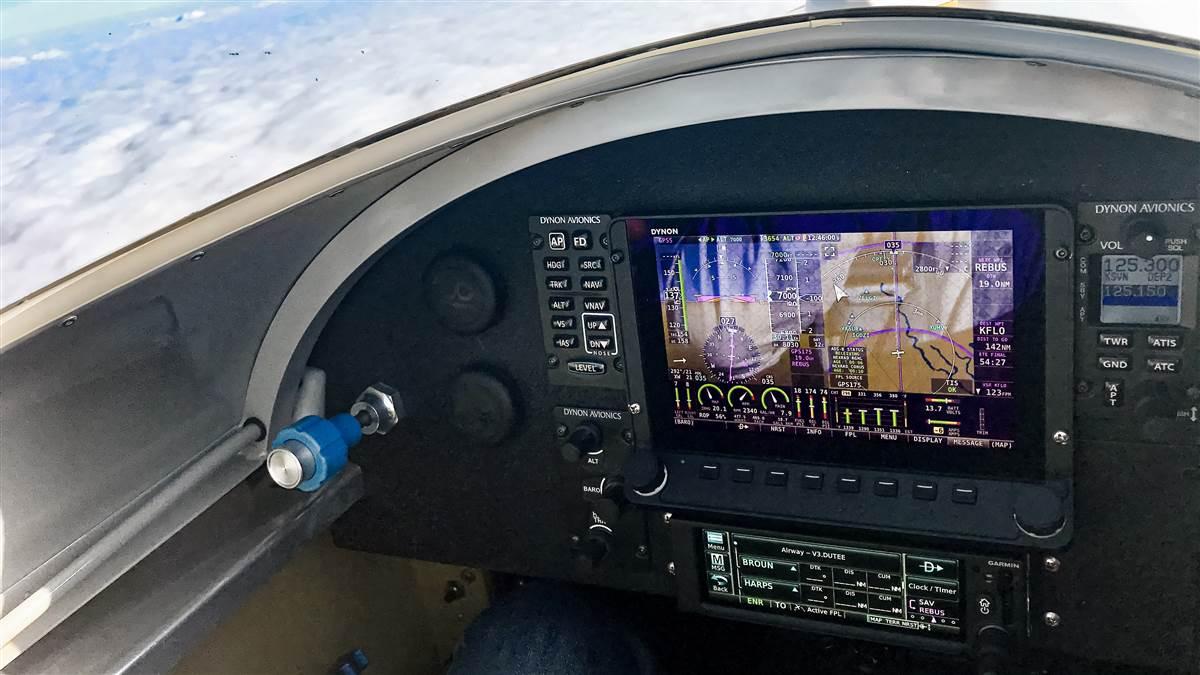Technology: Goodbye radio navigation
A purely satellite-based panel

Photography by Dave Hirschman
 It should be both aerobatic and efficient; maneuverable yet stable; capable of using short grass strips and big city airports; include a tailwheel, have excellent visibility, and be appropriate for local formation hops yet capable of night and IFR.
It should be both aerobatic and efficient; maneuverable yet stable; capable of using short grass strips and big city airports; include a tailwheel, have excellent visibility, and be appropriate for local formation hops yet capable of night and IFR.
My Van’s RV–4 did all of those things except for IFR—and now, thanks to the addition of a Garmin GPS 175, it does that, too.
Shoehorning an IFR panel into the narrow confines of a sport airplane has traditionally been way more trouble than it’s worth. There simply isn’t enough space in slim panels and short avionics bays to hold the required instrumentation, and the equipment was heavy and hungry for electrical power that small engines and alternators couldn’t realistically supply.
Now, times have changed. The current generation of light, digital, glass-panel avionics makes it not just possible, but economically feasible, for sport airplanes like a 1,000-pound (empty weight) RV–4 to get the safety and redundancy of IFR avionics that show weather, traffic, terrain, and more.
My upgrade path included a Dynon SkyView HDX display ($3,200) with a backup battery (“Avionics: Dynon HDX Upgrade,” July 2020 AOPA Pilot), a GRT Avionics Mini standby instrument ($1,400), and finally a Garmin GPS 175 ($4,300) as the FAA-required, IFR-certified, panel-mount navigator.
The GPS 175 is an outlier for Garmin because of its minimalist nature: It only provides WAAS GPS approaches. If you want to fly ILS, localizer, or VOR approaches, forget it. The 175 doesn’t have a radio, a remote transponder, an audio panel, or any of the other goodies Garmin likes to bundle in its avionics.
The 175 does one thing, and one thing only—WAAS—but it’s enough for most IFR pilots.
 Just about every runway served by an ILS approach in the United States also has a (WAAS) LPV approach with similar minimums. The tipping point at which GPS-only became viable in the United States has already been reached and surpassed.
Just about every runway served by an ILS approach in the United States also has a (WAAS) LPV approach with similar minimums. The tipping point at which GPS-only became viable in the United States has already been reached and surpassed.
There were more than 4,000 LPV approaches in the United States in mid-2020 serving about 2,000 airports. Put another way, there already are more than twice as many LPV approaches as ILS procedures—and the LPV lead is accelerating.
When you consider the total number of GPS approaches, they currently outstrip all ground-based procedures combined. There are roughly 7,000 GPS approaches in the United States—more than all ILS, VOR, NDB, and localizer approaches.
I reviewed my own flying for the last 12 months and found that all of the 30-something airports I flew to (from Yakima, Washington, to Brunswick, Georgia) have GPS approaches suitable for a GPS 175.
The 175 does one thing, and one thing only—WAAS—but it’s enough for most IFR pilots.Looking at the finished panel, I’m amazed at both its vast capability and its sparseness. It provides exceptional situational awareness in flight, yet the boxes and their wiring only weigh about 10 pounds total and use less than 10 amps—a minimal electrical draw for the airplane’s 40-amp alternator.
I’m acutely aware of the airplane and panel’s limitations. There’s only one aircraft battery (and a standby for avionics, only), one alternator, one autopilot, one transponder, one ADS-B receiver, and one engine. So single-point failures are a real concern. There also are no deice or anti-ice systems, so it’s not an airplane for all seasons.
My first big trip in the airplane was a 12-hour, four-leg flight to Florida and back that involved three approaches (two LPVs and an LNAV+V). The experience also reinforced the idea that, with a minimalist panel, everything must work. An erroneous warning about what turned out to be a nonexistent alternator issue almost caused me to turn back on an IFR leg.
Also, unlike larger Garmin displays, the GPS 175 can’t graphically depict an IFR approach procedure. That’s what tablet computers, portables, and paper printouts are for.
But when I think about the 1960-something Beech Musketeer in which I first ventured into the clouds, this new IFR panel is almost too good to be true. It’s got a primary and backup GPS, in-cockpit weather, real-time traffic, graphical terrain and obstacle warnings, solid-state reliability, and a digital autopilot with a Level button that can fly coupled instrument approaches.
And even with all that, there’s still some available panel space left over.
Email [email protected]



